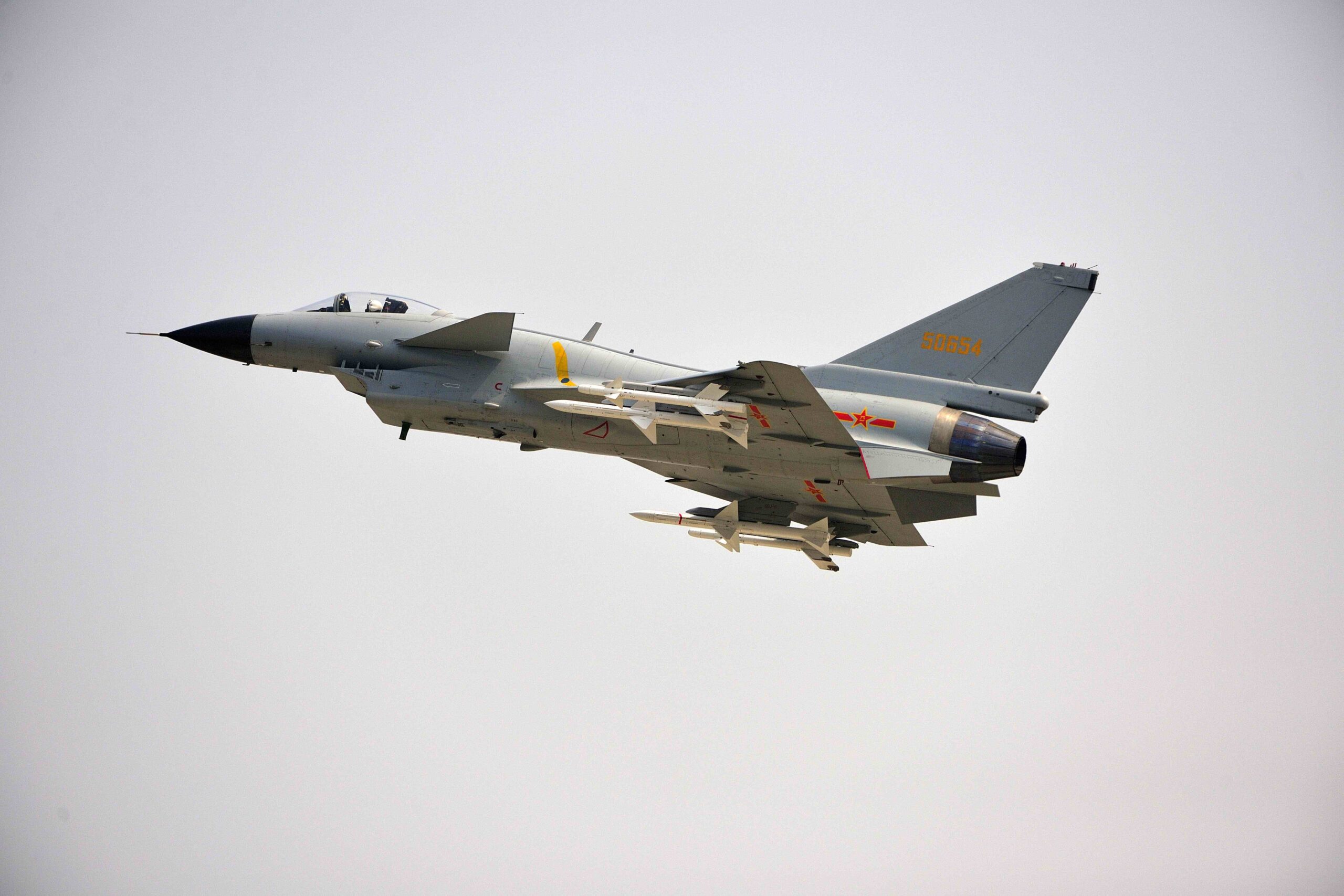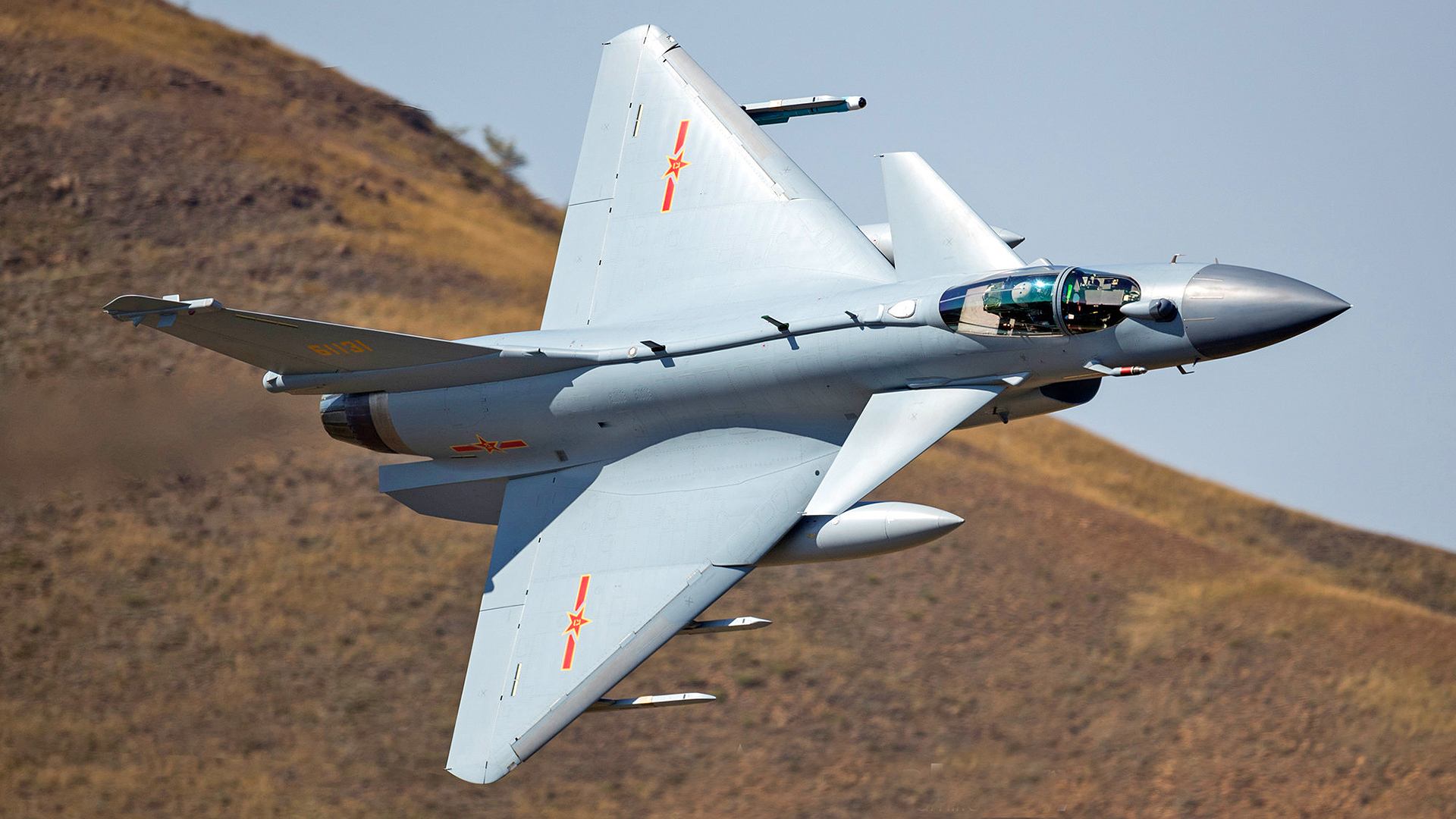On March 23, 1998, the Chengdu J-10 took its first flight. Also known as the “Vigorous Dragon,” the J-10 is China’s primary medium-weight, multi-role fighter. The J-10 is a highly successful indigenous fighter jet program, which one could argue has been the most critical and transformative of the modern era of the People’s Liberation Army (PLA).
In celebration of the jet’s 25th anniversary, Chinese state-affiliated outlet Global Times posted a short, 53-second video montage that could easily pass for a Top Gun cinematic trailer, featuring various J-10s performing aerial combat maneuvers and formations, as well as refueling and firing missiles.
It’s difficult to overstate the significance of the J-10. Prior to its ascension, China’s fighter jet inventory was a mix of mainly Soviet-produced aircraft and licensed-built versions of Soviet aircraft. While some indigenous fighters found success before to the J-10, such as the J-8, others were either abandoned or canceled. Work on the J-12, which began in the late 1960s, was abandoned in 1978. The J-9, which also began development in the 1960s, was canceled in 1980.

By the time work began on the J-10 in 1984, aircraft such as the U.S.-made F-16 Fighting Falcon and the Soviet-made Mikoyan MiG-29, introduced in 1978 and 1983 respectively, were pushing the boundaries of light-to-medium fighter capabilities. The J-10 eventually proved that China could produce an indigenous fourth-generation fighter equivalent, which was a massive leap in capability compared to what came before it. The J-10 was originally intended to replace the J-7 fighter and Q-5 attack aircraft and thus become the PLA’s standard multirole fighter.
Of course, the success of the J-10 extended beyond serial airframe production. It spurred innovation in Chinese domestic fighter jet engine technology, as well as the country’s domestically produced aircraft sensor and radar capabilities. In many ways, the J-10 represents something of a watershed marking the rise of China’s high-technology aviation sector as we know it today.

Early development on the aircraft, designed and built by the Chengdu Aircraft Corporation (CAC), was slow going. A design designated as the J-9VI or J-9B, which formed the basis of the J-10, was decided on in 1986. In the early 1990s, a full-size wooden mock-up of the aircraft was produced, which was completed in 1991.
As Chinese aerospace observer and author Andreas Rupprecht notes in his book, Modern Chinese Warplanes: Chinese Air Force – Aircraft and Units, problems with the J-10’s planned WS-10 engine almost derailed the entire project. Instead, many J-10s ended up using Saturn-Lyulka AL-31 engines, sold to China by Moscow, but this required rethinking the J-10’s design to accommodate the new engine. The first J-10 prototype was finished in June 1997, with the aircraft’s maiden flight taking place on March 23, 1998.

Despite representing one of China’s most successful indigenous fighter jets, much has been made of the possible connection between Israel Aerospace Industries (IAI) and CAC during the J-10’s development. By most all accounts, secret information was shared by the Israelis with CAC on the U.S.-financed Lavi, a fourth-generation Israeli fighter jet with a similar configuration that was developed during the 1980s (the aircraft was canceled in 1987). However, claims that the J-10 constitutes little more than a Lavi-clone negate some differences between the aircraft — including the J-10’s larger size, wing planform, two-dimensional air intake, and the location of its canards.

Complementing its delta wing configuration that lacks horizontal stabilizers, the J-10 features a pair of articulating canard foreplanes, making it quite agile. It has a distinctive air intake and a splitter plate below the fuselage, providing stable air to its AL-31FN engine. As the delta-canard is aerodynamically unstable, the J-10 features a digital fly-by-wire (FBW) control system.
The J-10 also features a number of other technologies, with early versions of the fighter using the Type 1473 fire-control radar, developed by the Nanjing Research Institute of Electronic Technology (NRIET). The J-10 also has other modern avionics typical of modern fighters, including a glass cockpit with a wide-angle head-up display (HUD), and multiple multi-function displays.
Most of the early J-10A aircraft carried China’s domestically produced PL-8 short-range infrared-guided air-to-air missile (AAM) and the PL-11 semi-active guided medium-range AAM, which were subsequently replaced by the active radar-guided PL-12 medium-range AAM. More recently, modern PL-10 advanced short-range missiles and active radar-guided PL-15 missiles are increasingly replacing the PL-8 and PL-12 on People’s Liberation Army Air Force (PLAAF) J-10s. You can read more about these missiles and China’s wider air-to-air missile inventory here.
The aircraft can carry a wide array of air-to-ground and anti-ship weaponry. For instance, in conjunction with its targeting pod, the aircraft can carry guided air-to-ground weapons, like the LS-500J precision-guided bombs or the newer GB1/TG500.


In addition to the J-10A and the land-based naval J-10AH variant, China developed a tandem two-seat variant known as the J-10AS or, in naval use, the J-10ASH. The two-seater J-10AS made its first flight in 2003 and was certified in late 2005, entering service with the PLAAF soon after that. The J-10 twin-seater features an enlarged dorsal spine that houses some of the aircraft’s electronics.

The last of the initial J-10A models were completed in early 2014. During the period between 2002-2014, Rupprecht indicates, more than 224 single-seat J-10As and around 48 twin-seat J-10AS were produced. This included the Naval Aviation J-10AH and its equivalent twin-seater J-10ASH as well as some dedicated aerobatic examples.


The next series-production version of the J-10, the J-10B, was first revealed in March 2009. The aircraft uses the Saturn-Lyuika AL-31FN Series 3 engine, with increased thrust compared to older models. Moreover, the J-10B features a new fixed diverterless supersonic inlet (DSI), a concept also found on the F-35 Lightning II. A new indigenous infrared search and track (IRST) and laser rangefinder ball in front of the canopy was included, as was an updated glass cockpit with three large color MFDs, a helmet-mounted display, and a wide-angle holographic HUD.

In terms of other equipment, the J-10B featured a new radar under its recontoured radome — a passive electronically scanned array (PESA) system operating in the X band. Developed by the No. 607 Institute, this radar was supposedly the first of this kind ever produced for a Chinese fighter. As Rupprecht suggests, it was thought that the J-10B would be equipped with an active electronically scanned array (AESA) developed by the 14th Institute, but this radar was not ready in time. A series of other delays meant that serial production of the J-10B did not begin until mid 2013.

The J-10C variant was first seen shortly after this in late December 2013. In 2016 the J-10C superseded the J-10B in production, and incorporated an AESA radar. Equally significantly, from around 2019, the J-10C has also been fitted with the indigenous Shenyang WS-10 engine — China’s first successful turbofan fighter engine. One J-10B aircraft has been tested with a thrust-vectoring version of that engine, although it remains unclear if this is intended for future production versions, too.
According to Rupprecht, the J-10B was built in one batch of around 56 aircraft. Since 2015, all subsequent aircraft have been J-10Cs. Although production of the J-10C continues, it is difficult to estimate how many airframes have been produced due to a lack of readily available information.

Since then, a new variant of the J-10C has emerged. The J-10CY, which we first caught sight of last year, was designed specifically for the PLAAF’s “Ba Yi” aerobatics team. The J-10CY will be replacing the J-10AY in this role, although it remains unclear if the transition to the new aircraft has been made beyond testing. The type could have a secondary developmental role, as well.
Of course, China’s rapid ascension in terms of tactical aircraft development has not stopped at the J-10, it has only accelerated beyond it. The J-20 stealth jet constitutes the country’s most advanced in-service fighter jet. The J-20 first broke cover in December 2010 ahead of its maiden flight in January 2011. It entered service with the PLAAF in September 2017, and it’s been suggested that somewhere in the region of 70 to 150 airframes have been produced. A new J-20B variant, which could feature a range of updated capabilities, has been anticipated for some time. There is also the two seat J-20 model that has emerged and could also have major tactical implications.

Maybe the most relevant ongoing fighter program in relation the J-10 has to be the Shenyang J-31/J-35/FC-31 medium-weight stealth fighter initiative. The design has been increasingly refined over the better part of a decade and the People’s Liberation Army Navy seems to making the most visible progress with its navalized variant of this aircraft. But if China’s air force decides to pursue a J-10 replacement in the near term, it is likely to come in the form of the J-31 and possibly unmanned aircraft to be paired with it.

Beyond this, there are indications that China is also developing its own sixth-generation manned fighter in response to the U.S. Air Force’s Next Generation Air Dominance program, or NGAD. While little is known about that aircraft, it’s possible that it could feature a tailless configuration as The War Zone suggested in January this year. You can read more about earlier indications that China has been experimenting with modern tailless fighter jet configurations in recent years here.
That said, the J-10 remains a staple of China’s arsenal of fighter jets, examples of which have been involved in various provocative drills and escalatory displays up against and over Taiwan’s median line in recent years. It should be mentioned that the PLAAF isn’t the only air force to use the J-10. In late 2021, Pakistan’s then-Interior Minister Sheikh Rasheed Ahmed announced that the Pakistan Air Force (PAF) would be receiving 25 jets from China, in part to help counter Dassault Rafale jets bought by India.

While the exact number of J-10s the PAF has received from China isn’t clear — some reports note that the PAF could receive 37 airframes — early indications that Pakistan would receive the J-10C variant were confirmed upon arrival of the first J-10s to the country.
More recent advancements in Chinese fighter jet capabilities, including the development of stealth technologies and rumored sixth-generation aircraft, would almost certainly not have been possible without the J-10. And, 25 years after its first flight, it retains a special place in history and within China’s current airpower inventory.
Contact the author: oliver@thewarzone.com
